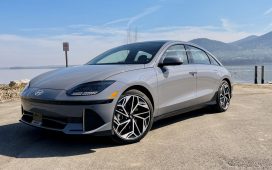For no reason at all, today seemed like a good day to reflect on where our obsession with supersized SUVs and trucks has taken us and where it’s headed with the shift to electric vehicles.
I’m kidding, of course. Because today was the day that GM unveiled a brand-new Cadillac Escalade — only this one is electric! The Escalade IQ looks every bit as stately and luxurious as its gas-powered predecessor and is sure to be the EV of choice for wealthy people to be chauffeured around their city of residence.
But big SUVs like the Escalade come with major tradeoffs. And when you throw an equally large lithium-ion battery into the mix, those tradeoffs start to erode the environmental benefits of driving an electric vehicle.
Big SUVs like the Escalade come with major tradeoffs
Most EVs are extremely heavy, thanks to those lithium-ion batteries just chilling beneath the floorboards. Batteries are certainly better than gas tanks when taking into account tailpipe emissions. But all that added poundage is extremely problematic for traffic safety, parking, and the environment.
Take pedestrian safety, for example. If you have the unfortunate luck to be hit by a car, it won’t matter whether it’s running on dinosaur sludge or clean, zero-emission electricity. That’s because it’s the size and shape of the vehicle, not the power source, that will help determine whether you live or die in this scenario.
Bigger vehicles, like trucks and SUVs, are more likely to kill a person than sedans or station wagons. A lot of that has to do with geometry. When a car is low to the ground, it is more likely to hit a person in their legs, causing them to land on the hood and roll off. It sounds terrible, but there is a greater chance of surviving such a strike.
But a higher-riding vehicle, like a three-row SUV with a huge, boxy front end, is more likely to hit someone in the chest or head — a death blow. And they are also more likely to fall underneath the vehicle, where they get crushed by the tires.
This is dangerous because drivers of these vehicles often find it difficult to see people and objects — even when they’re right in front of the grille. The last time I drove an Escalade was in 2020, and I was truly taken aback by the ride height. Sitting in the driver’s seat, it’s easy to feel disconnected from the outside world, mostly because you can’t see a lot of it. The grille was like a sheer cliffside, obstructing my view several feet out in front of the wheels. An entire kindergarten class could be lined up in front of this vehicle, and I wouldn’t see them.
This isn’t hyperbole; a local news station in Indianapolis investigated front blind spots and found the Escalade’s to be the most egregious at 10 feet, two inches, with the driver sitting in a natural, relaxed position. It took 13 children seated in a line in front of the Escalade before the driver could see the tops of their heads.
All that added poundage is extremely problematic for traffic safety, parking, and the environment
Another issue is weight, and the Escalade is in a class of its own when it comes to that. GM hasn’t released the curb weight of the new Escalade IQ, but it stands to reason that it will outweigh its gas equivalent — by a lot.
Heavier vehicles are inherently more polluting than lighter ones, regardless of whether they emit any tailpipe emissions. All vehicles produce non-exhaust emissions from a variety of sources, including rubber tires, road dust, and brakes. This is especially true for electric vehicles, thanks to the added weight from their batteries.
These non-exhaust emissions “can in fact be higher for electric vehicles than for their conventional counterparts,” notes the Organization for Economic Cooperation and Development, “as the heavy batteries in electric vehicles imply that they typically weigh more than similar conventional vehicles.”
All vehicles produce non-exhaust emissions from a variety of sources
Take the Hummer EV, for example, another GM-produced electric behemoth that rides on the same battery platform as the Escalade IQ. The Hummer EV’s battery alone weighs 2,923 lbs, which is heavier than a Honda Civic. That battery has around 212 kWh of capacity; Cadillac says the Escalade IQ’s battery will also be “more than 200 kWh” for 450 miles of range. GM is willing to pack on the pounds if it means posting best-in-class range figures.
The problem, though, is these huge batteries come with serious environmental consequences. First, it requires mining more minerals, like nickel, cobalt, magnesium, and aluminum. GM is adding aluminum to its battery chemistry so as to reduce cobalt by 70 percent — which is admirable because cobalt has been linked to human rights abuses in mining operations.
Either way, the US doesn’t have enough capacity to mine and process all these minerals, which raises the issue of how we allocate these materials and why should we be putting so much of them into oversized batteries for oversized trucks and SUVs.
As noted by David Zipper, visiting fellow at Harvard Kennedy School and contributor to The Verge, one Hummer EV battery — or one Escalade IQ battery, for that matter — is roughly equivalent to three batteries for an electric sedan. Or even 300 e-bike batteries. “Every Hummer EV wastes minerals that could’ve powered additional EVs,” Zipper writes on Twitter.
GM does make the much slimmer Chevy Bolt, as well as more entry-priced EVs, like the Chevy Equinox EV. But the auto industry has largely pivoted away from sedans and small cars in favor of big, boxy SUVs and trucks. And now EVs are following a very similar path.
The solution, as Zipper and others have noted, is more diversity in lineups. Smaller, more efficient EVs, different form factors, even golf carts — yes, golf carts — can be a welcome antidote to the parade of battleship-shaped EVs that are currently dominating the market.
The people with large families who want more space, who need storage and towing capacity, and who like sitting up among the clouds as they drive — those people’s needs are being served by the industry. That market is met. It’s everyone who wants something smaller, more efficient, and less environmentally damaging that’s still wondering when their electric dreams will come true.











